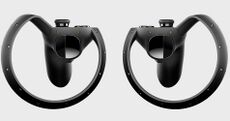Oculus Touch controllers
The Oculus Touch controllers are handheld gadgets designed for use with Oculus virtual reality headsets. The controllers feature buttons, triggers, thumbsticks, and sensors that allow for precise tracking of hand movements and gestures within the virtual space. They are used to interact with and control virtual environments in VR games and experiences. They were released December 6, 2016.
Release and prices[edit]
On October 11, 2017, during the Oculus Connect 4, Hugo Barra, Oculus' Vice President of Virtual Reality, announced the permanent price reduction of Oculus Rift and Touch bundle to $399.
On March 1, 2017, price of Touch was reduced to $99 and additional sensor cost $59. Note that Touch comes with 1 Oculus Sensor.
In July 2017, the price of Oculus Rift CV1 bundled with Oculus Touch was reduced to $499. Note that the bundle does not come with the Xbox 360 Controller nor the Oculus Remote, but it does come with 2 Oculus Sensors.
Oculus Touch was revealed alongside Oculus Rift CV1, on June 11, 2015 during Oculus VR's Pre-E3 Special Live Event. Reservation for Touch began on January 6, 2016 with the pre-order of the Rift. Oculus Touch will release on December 6, 2016 for $199. With pre-orders starting on October 10, 2016.
Touch ships with an Oculus Sensor for 360 degrees VR experience. Additional sensor can be purchased from $79 for Room-scale VR experience.
Hardware[edit]
Traditional Controls[edit]
One wireless Oculus Touch is held in each hand. 2 Oculus Touch controllers are designed to operate simultaneously. Some of the controller's features are similar to that of a traditional gamepad. It has 1 analog stick and 2 buttons on top and 2 triggers, 1 for the index finger located in front and 1 for the middle finger on the side. Additionally, the controller features capacitive sensing. Every input on the device, besides the side trigger, can sense the user's touch.
Tracking[edit]
Oculus Touch achieves 6DOF tracking through the same Constellation tracking system as the Rift headset. IR LEDs are placed on the controllers' bodies and rings, allowing them to be tracked by the same positional tracking sensor(s) that tracks the headset. The LEDs on the outer rings prevent occlusion caused by your hands. In addition to positional tracking, controllers possess built-in IMUs that allow rotational tracking.
Gesture Sensing[edit]
The gadget has a matrix of sensors mounted inside that keep track of your fingers and detect hand gestures. The only 2 fingers that the controller do not detect are the pinky and the ring finger.
Ergonomics[edit]
You grip the controller similar to how you shake someone's hand. Your thumb is placed on top of the controller and handles the analog stick and 2 buttons. Your index finger is placed in front and is responsible for a trigger there. Your other 3 fingers grip the handle of the controller with your middle finger responsible for a trigger on the side.
When you hold the controller, your hand is in a comfortable natural resting position. When you grab something or pick something up in VR, you activate the side trigger with your middle finger and grip of your hand becomes tighter. It simulates the natural motion of grasping an object in real life.
